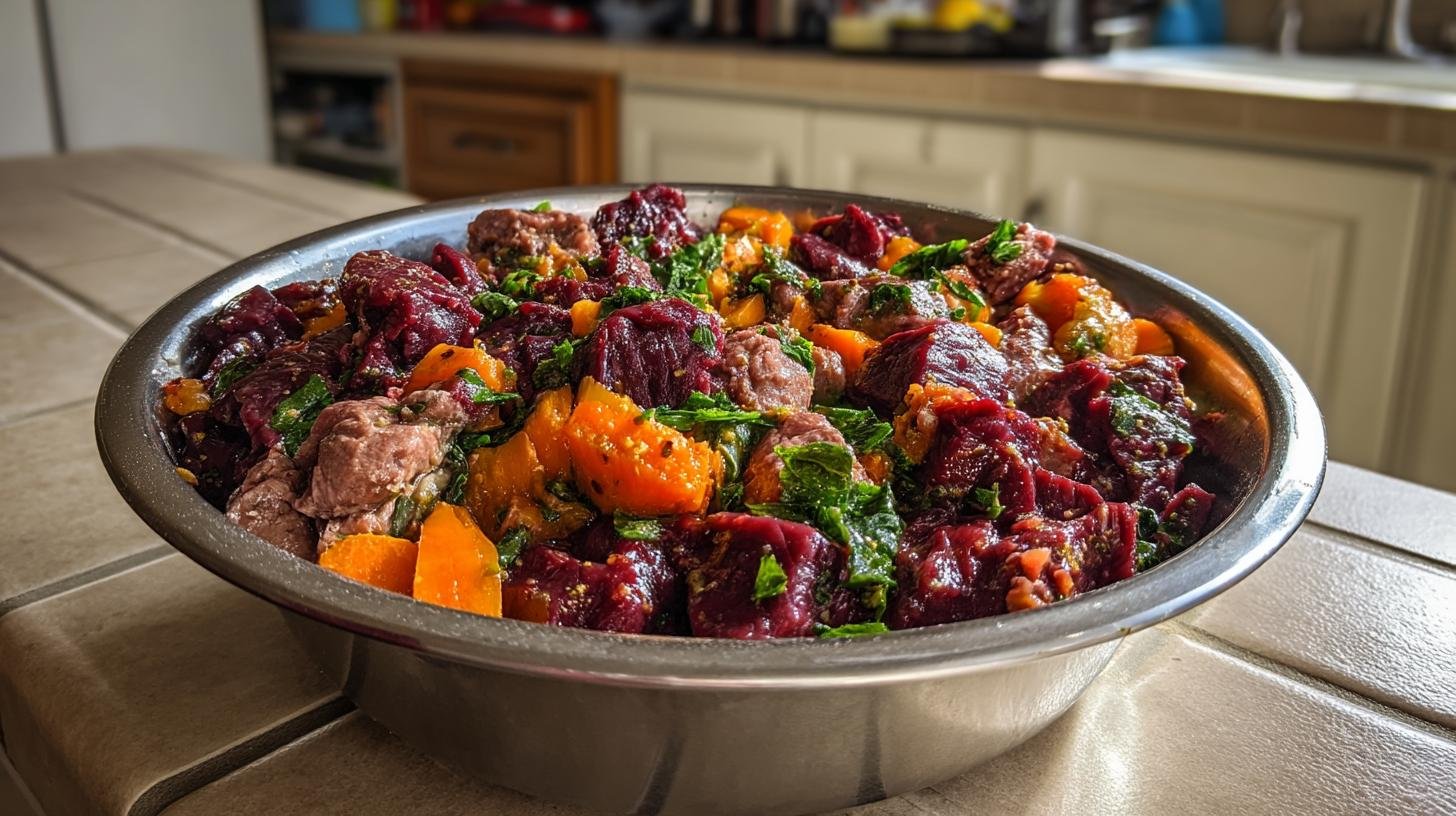When my golden retriever, Max, started having itchy skin and constant tummy troubles, I felt helpless. I tried switching kibble brands, adding toppers, even those pricey “sensitive stomach” formulas—but nothing really helped. That’s what led me down the rabbit hole of raw food prep for dogs. I was nervous at first, but after talking with our vet and doing a ton of reading (and yes, watching way too many YouTube videos), I started making Max’s meals myself—balanced, raw, and supplemented with the right extras.
The difference was incredible. Within weeks, his coat got shinier, his digestion improved, and he stopped scratching himself silly. What I love most is knowing exactly what’s going into his bowl—real meat, fresh veggies, and natural sources of nutrients like flaxseed oil and crushed eggshells. This isn’t just tossing raw meat in a dish—it’s thoughtful, vet-approved, and tailored to your dog’s needs. If you’re just starting out, don’t worry—I’ll walk you through everything I’ve learned (sometimes the hard way!) so you and your pup can thrive together.
Ingredients for Raw Food Prep for Dogs
Here’s exactly what I use when making Max’s go-to raw meal. These portions work well for a medium-sized dog, but you can adjust based on your pup’s size and activity level. Always go for fresh, human-grade ingredients—you’re feeding your best friend, after all!
- 500g raw chicken – chopped into bite-sized pieces; you can use bone-in (like wings or necks) for experienced raw-fed dogs, or boneless if you’re just starting out.
- 200g raw beef liver – rich in nutrients, but don’t go overboard; liver is powerful stuff.
- 1 cup chopped carrots – I peel and rough-chop them before blending.
- 1 cup chopped spinach – fresh or frozen both work; just avoid anything seasoned.
- 2 tbsp flaxseed oil – for those healthy omega-3s.
- 1 tsp crushed eggshells – a natural calcium source; make sure they’re clean and fully dried before crushing.
- 1/2 cup water (optional) – I add this if the mixture feels too dry or thick after blending.
That’s it—simple, real food. No fillers, no weird additives. Just wholesome ingredients your dog’s body can actually use.
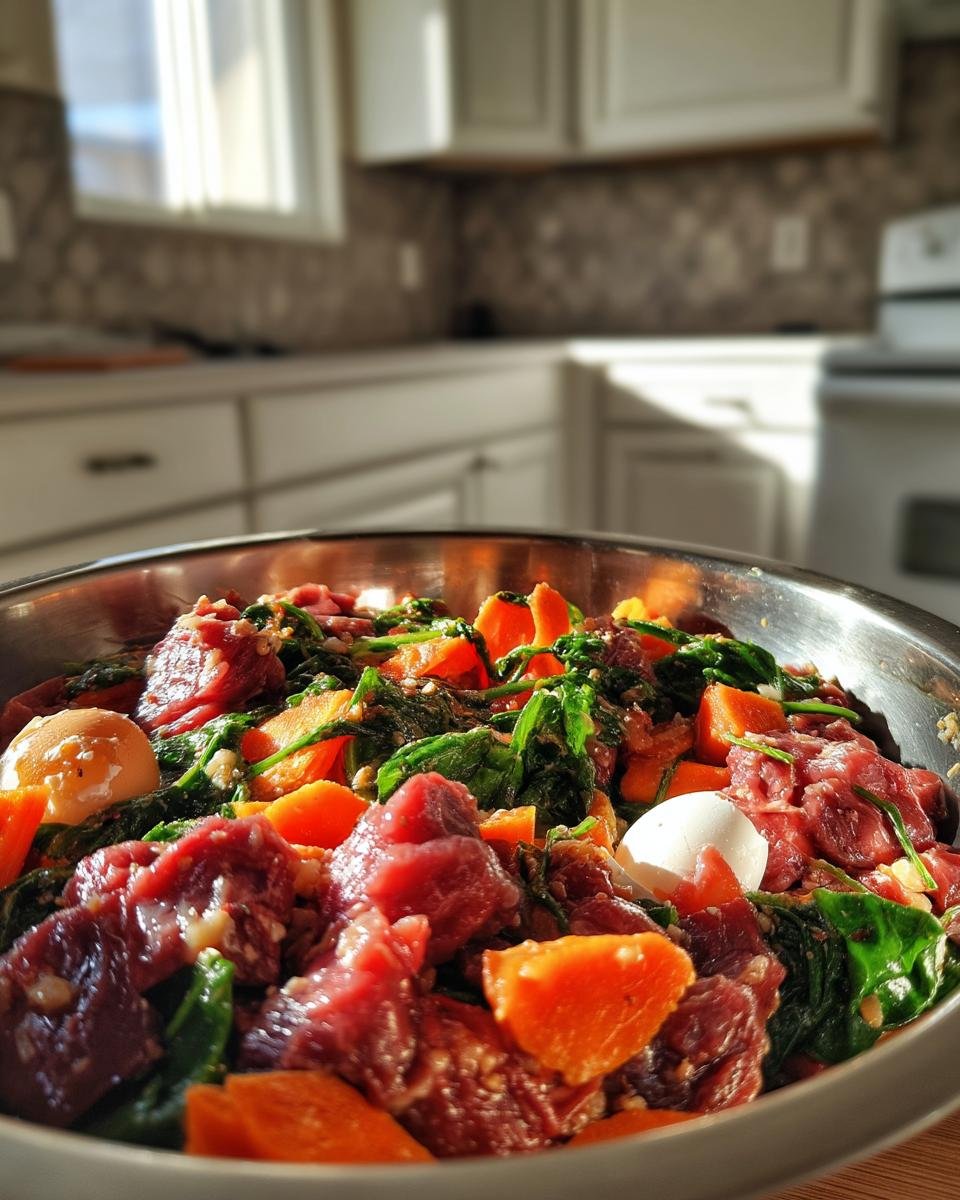
How to Make Raw Food Prep for Dogs at Home
Once you’ve got your ingredients ready, the process moves pretty quickly. I usually set aside about 20–30 minutes on a Sunday to prep Max’s food for the week. Just make sure your surfaces are clean, your hands are washed, and you’ve got some storage containers on deck. This stuff can get messy—in a good “I’m feeding my dog like royalty” kind of way.
Prepping the Protein
Start by chopping the raw chicken into bite-sized pieces. Think about your dog’s chewing style—Max is a gulper, so I go on the smaller side. If you’re using bone-in parts, like necks or wings, make sure your dog is experienced with raw bones and always supervise.
Next, toss the beef liver into a food processor along with the chopped carrots and spinach. Blend until it’s nice and smooth. It’ll smell… strong. That’s normal. Just don’t taste it—tempting as that liver shake might look (kidding!).
Quick safety note: Always wash your hands, knives, and cutting boards after handling raw meat. I keep a dedicated “dog bowl cutting board” in our kitchen just for this purpose.
Mixing and Balancing the Ingredients
Now for the fun part—grab a big mixing bowl. Combine the chopped chicken with the veggie-liver puree. Stir it up until everything’s evenly coated and the textures feel consistent.
Add in the flaxseed oil and crushed eggshells. I mix those in last so they don’t get lost in the goop. The oil adds shine and healthy fats, while the eggshells give a calcium boost. If it feels too thick or sticky, add that ½ cup of water to loosen things up just a bit.
Make sure there aren’t any dry spots or pools of oil—consistency matters for both nutrition and texture.
Portioning and Storing
Use clean, airtight containers to portion out meals. I like using silicone molds or stackable freezer containers. It makes daily feeding a breeze. Just scoop, thaw, serve!
Anything you won’t use in the next 2–3 days goes straight into the freezer. The rest stays in the fridge. Always thaw frozen portions in the refrigerator overnight—never at room temp. And definitely no microwaving! That can create hot spots or mess with the raw nutrients.
Label each container with the date so you know what’s fresh. I try to prep about 4–5 days’ worth at a time, rotating proteins every week to keep Max’s meals exciting and balanced.
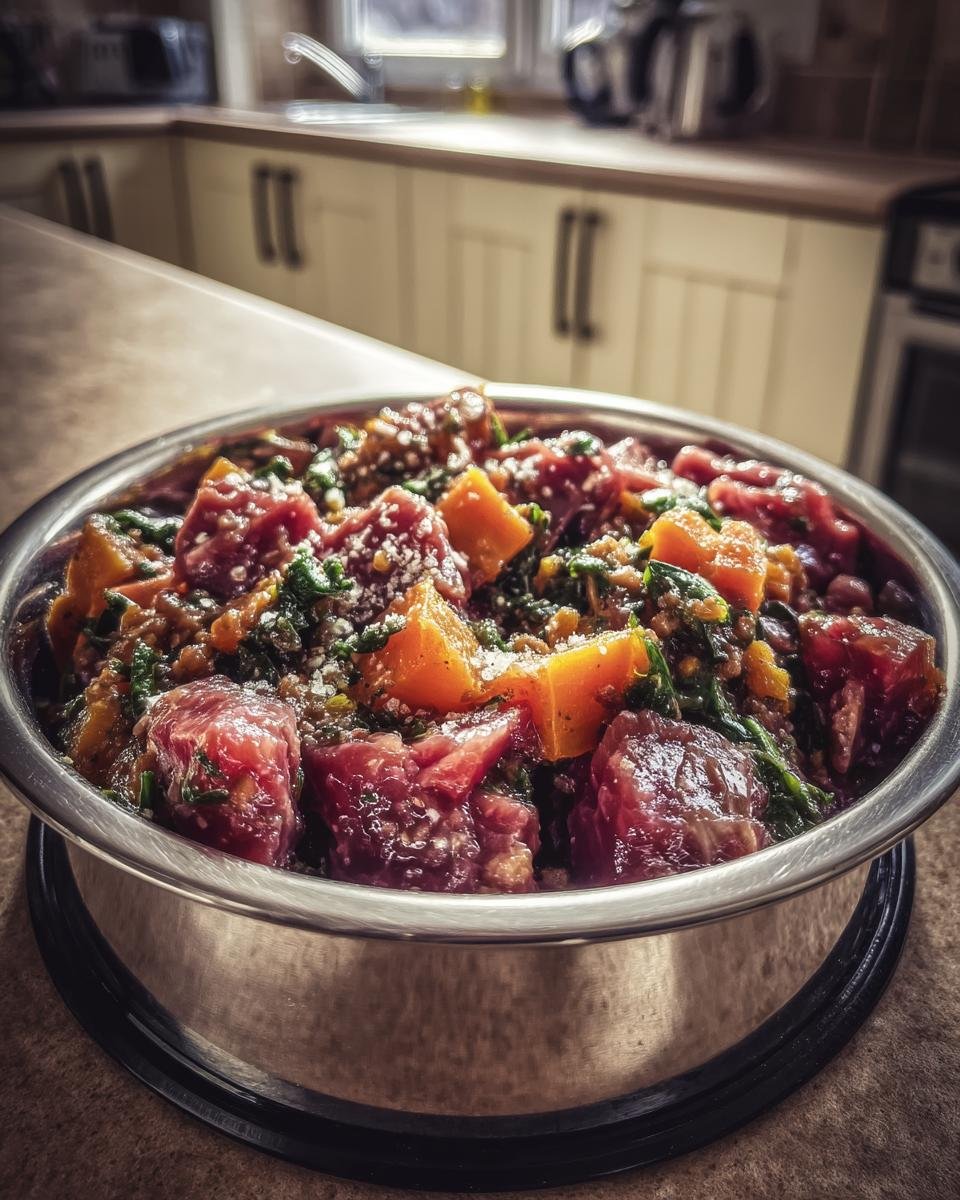
Why Raw Food Prep for Dogs Is a Smart Choice
The biggest reason I stick with raw food prep for dogs? I can see the difference. Max’s digestion is smoother, his coat looks like it belongs in a shampoo commercial, and his energy is through the roof (in the best way). Plus, I know exactly what’s going into his bowl—no mystery fillers or preservatives I can’t pronounce.
Our vet gave the green light early on, and even mentioned how rotating proteins helps cover all the nutritional bases over time. That’s why I don’t just stick with chicken—I swap in turkey, beef, or even duck depending on the week.
If you’re looking for better control, fewer tummy troubles, and a way to really customize your dog’s diet, raw feeding is 100% worth exploring. It’s not just trendy—it’s practical, nourishing, and honestly kind of fun.
Ingredient Notes and Substitutions
Every ingredient in this raw food mix serves a purpose—and trust me, I’ve tried plenty of swaps along the way. The chicken provides lean protein and, if you’re using bone-in parts, a natural calcium boost too. For beginners or smaller dogs, boneless is easier to portion and digest. Liver (I usually go with beef) is packed with vitamins A and B, but don’t be afraid to rotate in chicken or lamb liver for variety.
Carrots add crunch and beta-carotene, while spinach brings iron and fiber. You can sub in kale or even zucchini if your pup prefers a different veggie vibe. Flaxseed oil is my go-to for omega-3s, but fish oil works just as well—especially if your dog needs more joint support. And if eggshells aren’t your thing, a canine-safe calcium supplement will do the trick. Just keep it balanced and tailor it to what your dog thrives on.
Tips for Raw Food Prep for Dogs Success
Once you get into the groove, raw food prep for dogs becomes second nature—but a few smart tricks can make the whole process smoother (and cleaner!). Here are some of my favorite go-to tips:
- Use a food scale for accurate portions—eyeballing isn’t enough when it comes to balanced nutrition.
- Freeze in silicone molds or muffin tins for easy single-serve portions you can pop out and store.
- Don’t over-blend—keep some texture in the mix so your dog stays interested and gets the chewing benefit.
- Work in small batches when testing new ingredients or proteins to monitor your dog’s reaction.
- Consult a vet or canine nutritionist before making major changes—especially if your dog has allergies or health conditions.
- Keep everything clean—sanitize your prep space, tools, and hands like you’re working in a restaurant kitchen.
These little habits go a long way in keeping your pup happy, healthy, and excited for mealtime.
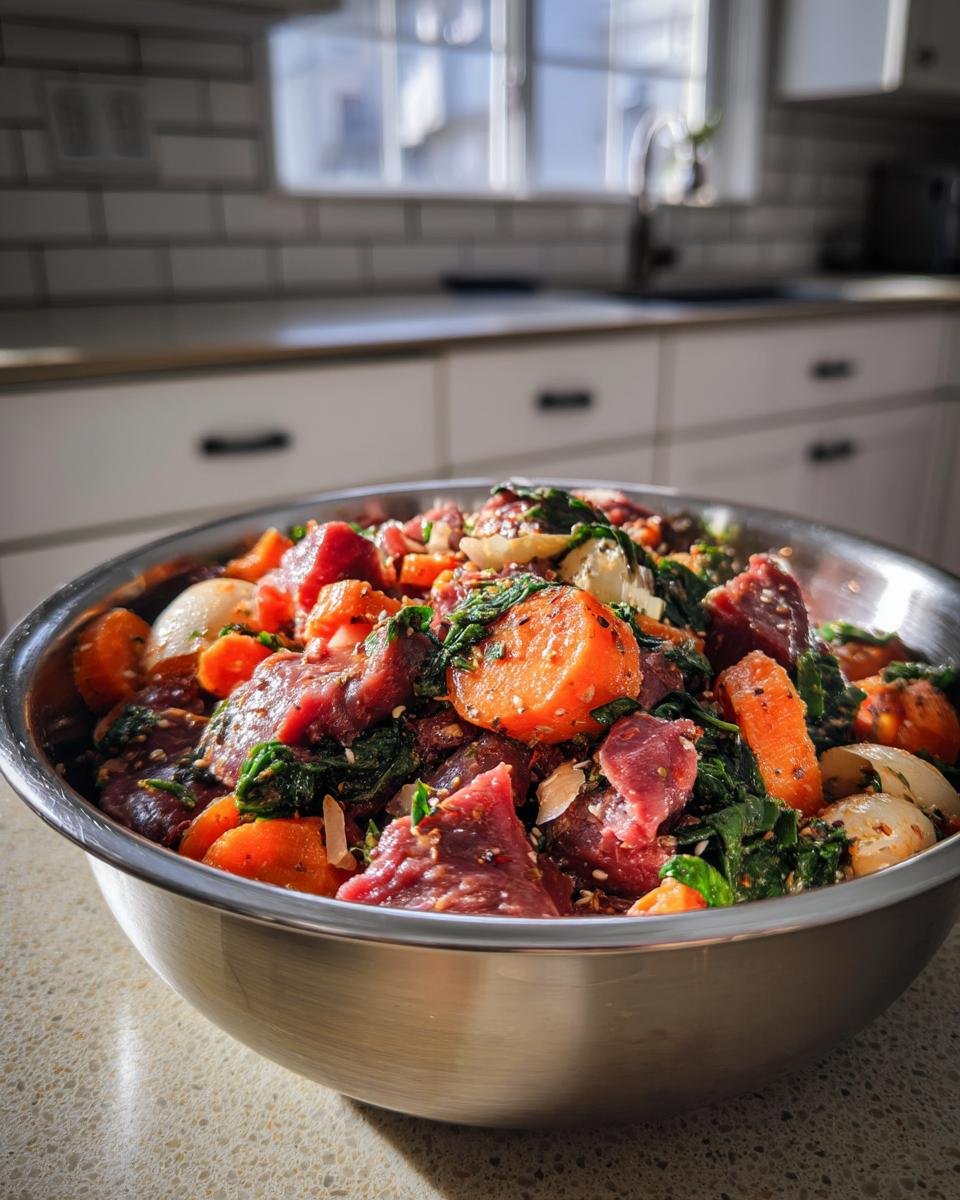
Storage and Reheating Guidelines
Once your raw meals are prepped, storage is key to keeping them safe and fresh. I portion everything into airtight containers—those stackable freezer ones are my favorite—and pop what I won’t use in the next 2–3 days straight into the freezer. The portions for the next couple of meals stay in the fridge, but never longer than three days max.
When you’re ready to serve, thaw a portion overnight in the fridge. Never thaw at room temp, and definitely don’t microwave it—raw food isn’t meant to be heated, and microwaving can create uneven hot spots or zap those nutrients we worked so hard to include.
Label your containers with the prep date and rotate older meals to the front. Frozen portions will stay good for up to 2 months, so you’ve got plenty of flexibility. Trust me, your dog will still be drooling for it!
FAQ About Raw Food Prep for Dogs
Can I feed this raw food to my puppy?
Yes, but with a few extra steps. Puppies have different nutritional needs than adult dogs, especially when it comes to calcium and phosphorus for growing bones. I started Max on raw when he was about five months old—with our vet’s blessing, of course. Talk to your vet or a canine nutritionist to get the portions right and make sure you’re covering all the bases for proper development. You’ll likely need to adjust the amount based on your pup’s age, breed, and energy levels.
How do I know the portions are right?
This is where a food scale becomes your best friend. Most dogs do well with about 2–3% of their body weight in food per day, split into two meals. But every dog is different, so it’s always best to check with your vet (especially if you’re switching from kibble) to make sure your homemade dog food is balanced and not too much or too little.
Is it safe to feed raw chicken to dogs?
Absolutely, as long as you’re using human-grade meat and following safe handling practices. I always prep on a separate cutting board, wash my hands thoroughly, and sanitize everything afterward. Raw bones (like chicken necks or wings) can be safe too—but only when raw, never cooked. And always supervise during mealtime, especially if your dog’s new to the natural dog diet world.
Do I need to cook the vegetables first?
Nope! Raw veggies are totally fine—as long as they’re blended well. Dogs don’t digest plant matter as easily as we do, so pureeing helps break down the fibers and makes the nutrients more accessible. I don’t cook the carrots or spinach in Max’s meals, and he does just fine.
What if my dog doesn’t like liver?
Ah, the picky eater dilemma! Liver is super nutritious and important for canine nutrition, but some dogs aren’t fans of the strong flavor. You can try rotating in kidney or heart instead, or mix smaller amounts of liver with other proteins to ease them in. A little goes a long way, so don’t give up right away—Max wasn’t sure at first either, but now he licks the bowl clean.
Nutritional Breakdown
Here’s a quick look at the estimated nutrition per 1-cup serving of this raw food mix (keep in mind it’ll vary slightly depending on your exact ingredients and your dog’s portion size):
- Calories: 250 kcal
- Protein: 22g
- Fat: 15g (with 4g saturated, 9g unsaturated)
- Carbohydrates: 5g
- Fiber: 2g
- Sugar: 2g
- Cholesterol: 80mg
- Sodium: 45mg
This meal is rich in protein and healthy fats, with just enough carbs and fiber from veggies for balance. I use this as a base and tweak portions depending on Max’s energy level and weight changes. It’s a great place to start for building a solid, nourishing foundation for your pup’s raw diet.
Let Us Know How Your Raw Food Prep for Dogs Went
I’d love to hear how it went for you and your pup! Did your dog love it? Any tweaks or favorite protein combos? Drop a comment below with your experience, questions, or suggestions—you can even share a photo of your happy dog digging in! And if you tried the recipe, don’t forget to rate it. Your feedback helps other dog parents feel confident giving raw feeding a try too!
Print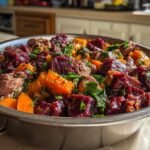
Raw Food Prep for Dogs: 3 Life-Changing Health Benefits
- Total Time: 20 minutes
- Yield: 4-5 servings 1x
- Diet: Gluten Free
Description
A balanced raw meal for dogs combining meat, vegetables, and essential supplements. Adjust portions based on your dog’s size and dietary needs.
Ingredients
- 500g raw chicken (bone-in or boneless)
- 200g raw beef liver
- 1 cup chopped carrots
- 1 cup chopped spinach
- 2 tbsp flaxseed oil
- 1 tsp crushed eggshells (for calcium)
- 1/2 cup water (optional for moisture)
Instructions
- Chop chicken into bite-sized pieces suitable for your dog’s size.
- Blend liver and vegetables in a food processor until smooth.
- Mix chopped chicken with the blended liver-vegetable paste.
- Add flaxseed oil and crushed eggshells, stirring thoroughly.
- Portion meals into containers and freeze unused portions.
- Thaw in the refrigerator before serving.
Notes
- Consult your vet before changing your dog’s diet
- Use fresh, human-grade ingredients
- Wash hands and surfaces after handling raw meat
- Store meals in airtight containers for up to 3 days in the fridge
- Rotate protein sources weekly for nutritional variety
- Prep Time: 20 minutes
- Cook Time: 0 minutes
- Category: Dog Food
- Method: Raw
- Cuisine: Pet Food
Nutrition
- Serving Size: 1 cup (varies by dog's weight)
- Calories: 250 kcal
- Sugar: 2g
- Sodium: 45mg
- Fat: 15g
- Saturated Fat: 4g
- Unsaturated Fat: 9g
- Trans Fat: 0g
- Carbohydrates: 5g
- Fiber: 2g
- Protein: 22g
- Cholesterol: 80mg

